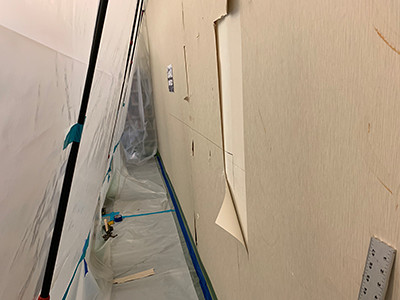AdvantaClean of Dublin Our Work
Case Studies
Location: Powell, OH 43065
Problem: If you don’t take the proper precautions, crawlspaces can be ideal mold breeding grounds. Moisture is your enemy everywhere in a house, but most especially in the crawlspace. Crawlspaces provide plenty of opportunities for water to enter and without proper controls that moisture can cause no end of problems. Wood rot, mold growth, nasty smells, insect invasion and damage… You name it and a crawlspace can breed it.
What can you as a homeowner do about keeping your crawlspace dry and problem free?"
Solution: Step one in any problem resolution is to stop the bleeding. If you have water entry you will have to get this under control. Take a tour of your crawlspace the day after a heavy rain and take note of any moisture intrusion:
-- Pooling water or flooding, either above or below any vapor barrier
-- Muddy areas of the crawlspace
-- Damp areas on the foundation walls
If you see any of these 3 indicators of moisture entry you’re going to have to find out why, and resolve that outside. It’s much cheaper and easier to deal with water outside than it is to deal with it inside.
Typically, I find most outside water management problems fall into one of the following categories:
-- Gutters are overflowing
-- Downspouts aren’t connected to drains or the drains are clogged
-- The grading of the yard (or patio) slopes towards the foundation
The easiest way to determine where you have problems with these issues is to perform an outside inspection of your perimeter during a heavy rain. Yes, it’s cold and wet and you really would rather not, but it’s the best method for seeing what’s really going on (and it's free).
Are your gutters overflowing? This is usually an indicator that leaves and other debris in your gutters or downspouts needs cleaned out. This can also happen if your gutters aren’t sloped correctly any more, but leaves are by far the main culprit.
Are your downspouts taking the water away from the house? If the downspouts aren’t connected to drains all that water is getting dumped directly outside your foundation. If the downspout is connected but the water is just boiling over the top of the drain you likely have a clog in your drain. This is usually either leaves or other debris or tree roots that have grown into the drain system.
Do you have standing water against the foundation of the house? Look at the grading, if your gutters and downspouts are all operating as they should. The ground should slope down and away from the house, taking the water away from the foundation. Trees and landscaping changes can all affect the flow of water outside.
If you find you have problems with any of these three things, this is the place to start. As I said at the beginning, it’s far easier to deal with the water outside than it is to deal with it inside.
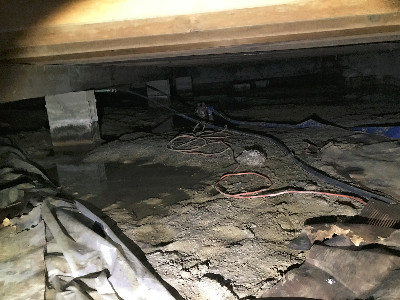

Location: Columbus, OH 43235
Problem: Most mold problems in attics are the result of poor ventilation. Cold air can’t hold as much moisture as warm air, and attics are cold in the winter. When downstairs air goes into the cold attic the relative humidity goes up. If it goes up too much too often, you get mold growth. There are two approaches to preventing mold growth in attics, and both should be utilized in order to keep your attic clean. We’ll explore one of the methods today – slowing the airflow from downstairs.
Solution: The normal airflow in a house is upwards, from basement or crawlspace, up through the first floor and second floor, then into the attic and out through the roof ventilation. This is caused by the “stack effect”, which is a result of air pressure differentials caused by temperature. Stopping the airflow is next to impossible, but slowing it down is both possible and a good idea. The more air that goes up and out through your attic in the winter, the higher the energy loss and the higher the risk of humidity buildup and mold growth.
How do we slow the flow? You identify the leak points and take steps to plug the leaks. The following list identifies some of the prime leakage points and what you can do to slow the flow:
Canned (recessed) lights
Problem: Canned lights in the ceiling directly below the attic can allow significant amounts of airflow. While there are sealed versions of canned lights, more often that not they are wide open pathways into the attic. If you use incandescent bulbs the effect is even more pronounced, due to the heat the bulbs generate.
Solution: You can either replace the light fixtures with sealed versions or install an aftermarket seal. The aftermarket seal kits are like big cups that go over the top of the light in the attic and get sealed with expanding foam.
Whole house fans
Problem: Whole house fans are designed to move large quantities of air from downstairs into and out of the attic. When not running they still allow a lot of air movement. You may think it’s stopping the air when it’s not running and the louvers are closed, but it’s still the equivalent of leaving a window open to the outside.
Solution: There are two ways to deal with sealing a whole house fan – cheap and easy from downstairs (good) or more labor intensive from the attic (best). The cheap and easy solution is to buy a magnetic cover for the fan that quickly installs over the face of the fan. This won’t stop all the airflow, but does get most of it. The more labor intensive solution is to build a box in the attic from rigid foam insulation, sealing the sides and base with expanding foam insulation. A lid is build using rigid foam insulation and installed with flexible hinges, so it automatically opens when in use and closes afterward (YouTube it). This is much more effective at stopping airflow and energy loss, but is a royal pain to assemble and install.
Bathroom fans
Problem: Bathroom fans provide a direct path for the stack effect from downstairs. Ideally, bathroom fans should vent through the roof. Frequently, they are ducked to either a soffit or exhaust vent, or are simply left laying on the insulation. Not venting through the roof allows a path for stack effect airflow when the fans are off. When they’re on after a shower they’re forcing damp, moist air into the attic space.
Solution: Vent the bathroom exhausts through the roof to the outside. Consider building a cap for the fan itself from rigid foam insulation (as with the canned lights). The boxes themselves are leaky around the perimeter.
Attic access hatch
Problem: Most attic access hatches consist of a square of drywall on a wood framework. They leak around the edges. Pull down attic stairs are even worse. They never really get a good closure all the way around.
Solution: Window or door foam sealing tape works wonders. $3 in materials and 5 minutes of time and you cut 90% of the airflow. For pull down stairs consider an insulated zippered seal. These are sized for the stair opening and completely seal the stairwell from the rest of the attic. These are a more expensive option (both time and money) but are much more effective for pull down stairs that never quite close.
Location: Delaware, OH 43015
Problem: Most mold problems in attics are the result of bad ventilation, rather than roof leaks. The air in your house is constantly rising, flowing from basement to 1st floor, then upstairs, then to the attic, then up and out. This flow of air is called the stack effect, and is present in every house. You can slow it down, but you can’t stop it. If you allow the air from downstairs to build up in the attic you can get a dramatic increase in humidity and condensation in the attic during the winter, which leads to mold growth on the rafters and roof decking.
Why does this happen? Cold air can’t hold as much moisture as warm air. As an example, let’s say the temperature and humidity in your house is 68F and 35%, which is pretty typical. 35% relative humidity means that the air is holding 35% of the maximum at that temperature. That same air at 50 degrees will have a relative humidity of 67%. It can’t hold as much, so the same amount of water vapor has “filled” the air more. At 39 degrees the relative humidity has already hit 100% and the extra moisture has begun to drop out of the air, condensing on the coldest surfaces like dew on the grass in a spring morning. The colder the attic is, the more moisture will be squeezed out of the air by the cold.
I’ve been in many attics on cold winter mornings where a thick layer of frost is all over the underside of the roof. As the sun warms the roof, the frost melts and it starts raining in the attic as the water drips off the nails poking through the decking. This is an ideal environment for mold growth.
How do you prevent your attic from becoming a frozen swamp?
Solution: There are two different approaches to preventing humidity buildup in the attic – slow the flow of downstairs air to the attic and speed the flushing of the downstairs air via ventilation.
In the next installment we’ll look at the steps you can (and should) take to slow the flow of air from downstairs into your attic. These steps are not only good for mold prevention, but they’re good for the gas bill as well.

Location: Columbus, OH 43235
Problem: This week we’ll be heading into the attic. While occasionally we see mold growth in attics that is the result of a roof leak, most of the time the root cause is poor ventilation during the winter months. Cold air can’t hold as much moisture as warm air. Air from the living space at normal temperature and humidity rises and enters your attic through the “stack effect”. You can slow down this flow of air, but you can’t stop it. When that air enters the cold attic the temperature goes down and the humidity goes up. Proper ventilation will vent this air to the outside before it can build up to humidity levels that spur mold growth.
Bathroom exhausts that exit into the attic can make a good situation bad and a bad situation worse. When showering, the bathroom exhaust dumps very moist air into the attic. When not in use it is still a problem, as it is a free path for the air in the living space to enter the attic. Many times we’ll see an attic that has good ventilation and is otherwise fine have a localized problem directly over the vent exit.
Solution: In the photos I show two different attics with growth from high humidity. One had gray fuzz blooming over every surface due to a total lack of ventilation in the space. During the winter the downstairs air would enter the attic. As a result, the humidity rose and stayed high because the moisture could not get out. Once the growth got a foothold in the attic it produced tens of thousands of spores per day, all looking for a comfortable place to grow. They didn’t have to go far, as every surface in the attic was damp and ready for planting. The growth spread like wildfire.
The other attic had sufficient total ventilation, but had a bathroom fan that exhausted into the attic. Unfortunately, the exhaust also vented into an area that was a bit of a dead end, as far as ventilation goes. As a result, the humidity in that area was consistently too high. The worst of the growth was mostly limited to that smaller area, however, because in the majority of the attic the ventilation was sufficient to keep the moisture from building up.
Finding mold in an attic that is the result of a ventilation problem is a matter of walking the attic with a flashlight. Shine the flashlight down along the rafters and decking, looking for powdery white / gray growth. Pay particular attention to the areas where bathroom exhausts come through from below, areas where canned lights are installed in the ceiling below (another good source of leakage), and down near the eaves. Growth is usually worse (or only) on the north side of the attic due to the angle of the sun in the winter.
Be careful where you step while in the attic. For safety, always maintain 3 points of contact. Two hands and one foot (while stepping forward) or one hand and two feet (standing)."
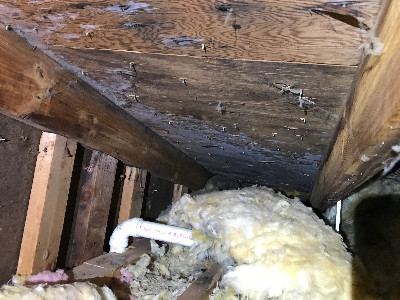
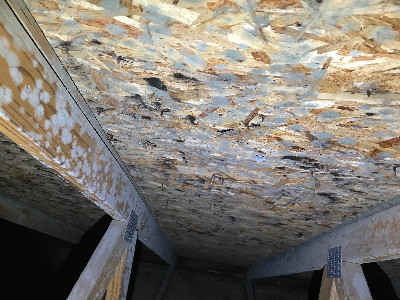
Location: Lewis, OH 443035
Problem: Finished basements are great ways to expand the living area in your home, and provide space for the perfect get-away spot. Maybe it’s a man-cave for you to get away from the rest of the family when the game is on. Or a kid-cave so the big Fortnite battle-royale doesn’t interfere with the nightly news. It’s about keeping families from being at each other’s throat.
Finished basements also combine the most favorable conditions for dangerous mold problems in a home. Aside from all the humidity issues basements can be subject to, they are also much more susceptible to flooding than any other room in the house. Combine that with carpet and drywall (mold candy!) and you have a perfect recipe for trouble if things go south.
Typical scenario: A big storm moves through the area. Lots of rain and wind. The power goes out and there’s no battery backup on the sump pump. The next day you find the basement carpet is wet. You quickly move the furniture from the wet room to a dry room, use the shop vac to pull out the worst of the water, then set window fans all over the room to dry things out. A few days later everything is good.
Solution: Here’s what really happened: The water from the sump wet the carpet. The carpet wicked the water to walls. The drywall touching the carpet sucked up water like a sponge. The fans dried the face of the drywall and the carpet. You know that, because you checked all over. What you missed was the back of the drywall and the cavity behind the wall stayed damp and moist. Also, the drywall behind the baseboard got no air at all and stayed damp long after you put the fans away. The damp drywall led to mold growth, all hidden from view.
This scenario is more common than you can imagine. Even if it hasn’t happened to you, it could have happened to the family that lived in the house before you did. How do find whether past flooding and poor drying technique has led to mold growth? You’re going to have to take a peek behind the baseboard and inspect all the areas where the back of the drywall is exposed.
To check behind the baseboard you’ll need a small prybar, a hammer, and a flashlight. If your baseboard is caulked you’ll need to cut through the caulk with a utility knife. Pick a section of baseboard in the middle of the wall and gently tap the flat of the prybar between drywall and baseboard. With care, you can do this without damaging either. Pull straight back with the prybar to open a crack behind the baseboard. Don’t try to use the drywall to force it open, or you’re likely to damage the drywall. Use the flashlight to peek behind the baseboard. If there’s growth back there, you will likely see it as a black or dark gray powder. If you find something, stop and call a pro. Ripping off all the baseboard at this point will throw clouds of spores into the air, and you really want to avoid that.
Checking the exposed back of the drywall is as simple as finding the exposed back and looking at it using a flashlight shining down the face of the drywall. The area under the stairs is often not finished. The utility room with the furnace and water heater will usually show the back of the drywall. Sump pit and utility closets are generally not finished. These are all areas where mold problems from flooding can show up.
Location: Powell, OH 43065
Problem: In the third installment of How To Find Mold we’ll be looking for black mold in the basement and crawlspace. Please note that we are not necessarily talking about “toxic black mold”, just mold that is black. There are tens of thousands of different mold types. Many are black but few are toxic. Most pose an allergenic risk, rather than a toxic risk.
Black mold is usually the result of water contact, rather than high humidity. For that reason we’re going to be looking in areas that are most prone to growth from contact with water.
Solution: Unlike the white fuzzy molds that thrive in high humidity, black mold is very easy to see. You just need to look in the right places.
First we’ll start on the joists and sub floor. You’re much more likely to see black mold contamination on the sub floor than you are on the joists. Water tends to drip off of the joists, but the sub floor can stay wet from either condensation droplets or a drip from above.
In the photo you can see a portion of sub floor that has leopard spotting all over the surface. This was likely the result of flooding in the basement. Either a plumbing leak sprayed the sub floor or the flooding cause so much humidity and condensation that water drops were present on the sub floor for an extended period of time. If you’ve got this sort of contamination it’s easy to see, you just need to look at the sub floor throughout the basement and crawlspace.
For the next inspection location you’ll need a short ladder in the basement to check the rim joist. The rim joist (or band joist) is the board that runs around the perimeter of the exterior walls of the basement and crawlspace. This is the base that supports your home. It’s vital that the rim joist not suffer water damage or mold growth. It is usually covered with fiberglass insulation, so will not be visible without removing the insulation. It’s quick and easy to take a peek behind the insulation, just wear gloves when you do so. Grab the square of insulation with one hand and pull it out. Look behind at the joist and put the square back.
In the photo you can see a rim joist that has had water issues. Usually, black rim joists are the result of what outside keeping the rim joist damp. THIS CAN CAUSE SEVERE DAMAGE. In addition to dealing with the mold, you must determine why your rim joists are wet and resolve that problem before the damage becomes so bad the wood needs replaced. All this is completely hidden to you by the insulation that is in the cavity unless you look.
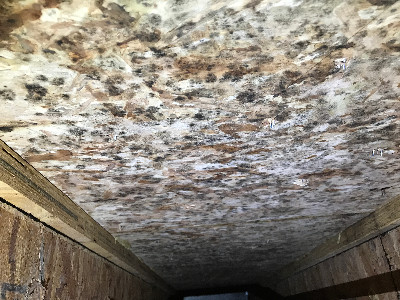
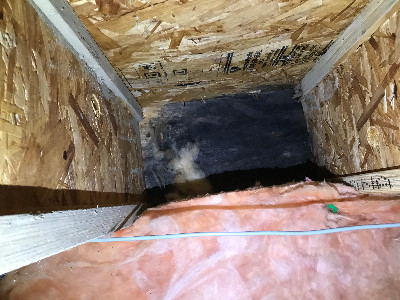
Location: Dublin, OH 43017
Problem: Mold contamination in the basement and crawlspaces can take many forms. In this next installment of How To Find Mold we’ll take a look at the how to examine the underside of the first floor, and what to look for.
Unfinished basements and crawlspaces pose the highest risk areas for humidity problems in your home, and the subsequent mold growth that happens when humidity isn’t controlled. Even if you don’t have water leaking in, foundation walls and slab floors are porous enough to let water vapor enter the basement. More often than not, the base of the crawlspace is the soil (or gravel on soil), which continuously puts water vapor in the air. A properly installed vapor barrier in the crawlspace will stop this, but I’ve seen countless vapor barriers ripped, holed, wadded up, or just plain poorly installed.
High humidity in unfinished basements and crawlspaces can lead to mold growth on the joists and sub floor above. Lets explore how to inspect your home to find out if you have a problem.
Solution: The tools you’ll need for your inspection are a short ladder or step stool, a bright LED flashlight with fresh batteries, and some knee pads for the crawlspace. Remember to take your reading glasses and your phone to take a few photos in case you find something.
Start in one corner of the basement, holding your flashlight at head height or higher, and pointing straight up. You should have one joist above your left shoulder and one above your right. You’ll be keeping the flashlight beam pointed straight up the joist, looking for white spotting or fuzz. Extend your arm forward, keeping the flashlight pointed up and a little forward and you can inspect about 4 feet of joist. Now check the joist over your other shoulder. Look down (so you don’t trip) and step forward. Repeat the process until you reach the opposite wall, where you’ll turn and inspect your way down the next pair of joists. Use the ladder whenever you find something you want to take a closer look at.
You will perform roughly the same process in the crawlspace, it’s just a bit tighter quarters. Don’t skimp on the crawlspace inspection just because everything has looked fine so far. The back end of the crawlspace gets the least air circulation of the entire space below grade and is at the highest risk. You’re going to have to go all the back, under the HVAC duct and behind the spider webs. If it’s a really tight squeeze make sure somebody knows you’re in there and you have your phone with you.
You’re looking for white fuzz or powder growing in solid patches at the bottom of the joist or in spots or patches on the face of the joist. Check the sub floor as well, but if the joists are clear there’s usually no problem with the sub floor. The photos show the two most common ways this type of mold appears on joists.
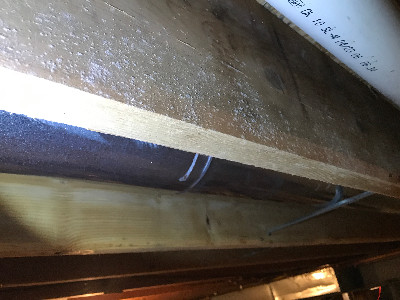
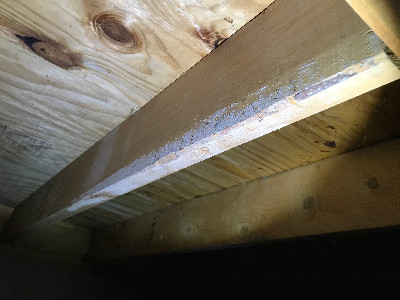
Location: Columbus, OH 43235
Problem: Mold growth can occur in a home for a lot of different reasons. One of the most common sources of trouble I run into is high humidity in the basement. Some types of mold don’t need actual wet water to thrive. Some molds do just great with relative humidity above about 60%, which is easy to hit in a basement or crawlspace without the right moisture controls.
The most common molds we see as a result of high humidity are Penicillium and Aspergillus. They are absolutely prolific in spore production, sending tens of thousands of spores into the air to spread misery throughout the house. Those same spores quickly lead to more growth everywhere the humidity is elevated, so a small problem in the basement can become a huge issue everywhere below ground in a short amount of time.
So how do you know if you have a problem? A visual inspection can be quick and easy with the right tools if you know what to look for. In the first of these lessons we’ll take a look at how to identify a mold problem on furniture.
Solution: When I’m performing an inspection in a basement, one of the first things I check are the items with finished wood. Tables, doors, that old shelf you’re not ready to throw away yet. For whatever reason, humidity loving molds loves them some varnished wood. If you have furniture in the basement, this is the first place to check.
Mold of this type is easiest to spot when you have a bright flashlight held at the correct angle. (Pro tip: Put fresh batteries in the flashlight before you start!). What’s the correct angle? Shine the light ACROSS the face of the surface, not AT the surface. The attached photos of a dresser with a mold problem are a great example. The first photo is the dresser in the normal light of the basement. You wouldn’t know there was a problem at all. The second photo of the dresser I’m holding the flashlight above the dresser shining straight down across the front. See all those white patches? That’s what we’re looking for. With the right light they practically glow.
Where do you look? For finished wood furniture in the basement:
-- Check the feet. Many times the dampness is worst nearest the slab floor.
-- Check the underside of the table or chair seat.
-- Check the backside of anything pushed against the foundation block wall. Moisture evaporates from the block walls and becomes trapped in the small space between the cabinet and wall.
-- Check the doors by holding the flashlight at eye level and pointed straight down. Look at the bottom foot or so of door.
Mold growth on painted furniture, particularly those painted white, can be a bit more challenging. Instead of looking for white on white fuzz you look for a change in the gloss of the finish, particularly in areas outlined above.
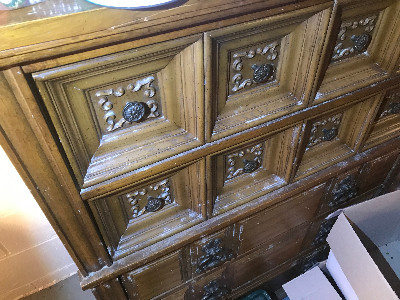

Location: Columbus, OH 43235
Problem: I typically only see this problem in condo units and apartments. The space isn’t very large, so the HVAC unit installed isn’t very large either. The unit sits on a box covered with drywall, through which the air return vent is mounted.
In the summertime the air conditioner inside the HVAC unit is constantly producing water from condensation, cooling and dehumidifying the air in the condo. The trouble comes if there are any leaks or the drain plugs up. When that happens the trickle of water ends up wetting down the drywall in the box immediately below the air conditioner. If this goes unnoticed for months (and it very easily can) you have perfect conditions for Stachybotrys growth, the black mold referred to when people talk about “toxic black mold”. It’s bad enough that the outside of the box is putting toxic spores and mycotoxins in the air, but the inside of the box is your air return! All the air you breath is blowing directly over the fuzzy black and green growth inside the box.
Solution: If you caught the leak early it may be as simple as fixing the leak or unplugging the condensate line. If you didn’t discover it until the problem had become much worse there is likely a mold remediation in your future. The drywall around the box will have to be removed under controlled conditions to prevent any more contamination in your living space. This is followed with an HVAC system cleaning and sanitation, to clean out all the spores that have been flowing through the system. What needs to be done after that really depends on the type and severity of the mold growth.
Best advice? Be proactive and check for moisture periodically. Catching the moisture issue early is the best way to prevent a nasty mold growth problem.
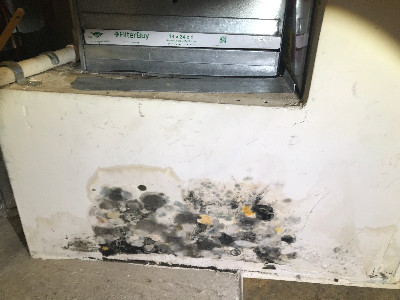
Location: Powell, OH 43065
Problem: The client had recently done some upgrades to the house. New insulation in the attic, vinyl siding on the outside. He’d gone into the attic to check that his insulation was working properly and found frost all over the roof decking and nail points. He called us in to tell him why it was happening and advise how to stop it. When I got there the sun was up, the roof was warming, and it had started raining in the attic as the frost began melting.
Solution: When the siding went up the under-eave vents had all been covered with perforated vinyl soffit panels. The vents that had allowed a free flow of air were now choked down to less than 10% of what they had before. His attic couldn’t breathe. Because of the ventilation problem humidity was building during the day. At night, when temps dropped, the excess moisture was frosting on the cold roof decking. When the sun comes back up the roof starts warming, the frost melts, and the cycle starts again. Conditions like this are ideal breeding grounds for mold growth. The repeated cycles of wetting and warming grow mold faster than last month’s bread.
The solution? The intake vents had to be opened back up. Simply removing the soffit panels restored the ventilation and solved the immediate problem of moisture buildup and frost. The permanent fix requires replacing the panels with others having a different perforation pattern, one that allows much greater airflow.
Luckily, we got to this one before mold growth had appeared. Another month or two and the situation would have been much worse.
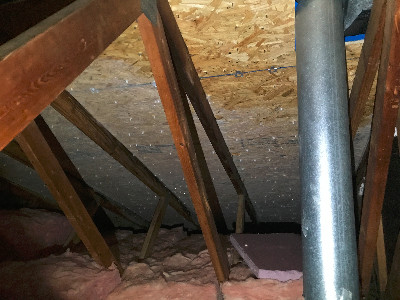
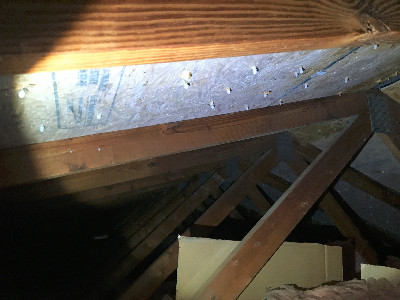
Location: Cardington, OH 43313
Problem: I was just in a crawlspace of a house less than a year old. The contractor had intended to install a vapor barrier in the crawlspace but simply had forgotten it. The plastic was rolled out in the crawl and cut to length, but they had forgotten to spread it out. The relative humidity in the crawlspace when I arrived was 82%, well above the 60% level considered to be where trouble starts.
There was mold on every joist in the crawlspace and much of the sub-floor. Black mold, white mold, yellow mold, gray mold – mold of every description. The mold growth was thick enough to cut with a knife. And it had all happened so fast! This wasn’t something that took years to develop, it happened in months. In the right conditions mold spreads incredibly quickly.
Solution: Mold remediation in a crawlspace starts with protecting the rest of the home. Containment of the airborne spores is paramount using heavy gauge film and HEPA air scrubbers to clean the air and create a pressure differential. Mold removal in the space is performed using HEPA filtered vacuums and wire brushes to ensure not just the surfaces spores are captured, but the hyphae (mold roots) that have gotten into the wood are removed as well. Once the mold removal on the wood is complete the entire crawlspace is wiped down with an anti-fungal agent.
Another HEPA vacuuming is performed to ensure there is simply no more mold – dead or alive. This is because dead spores cause all of the same health issues as live ones. It’s also why just spraying or fogging the area is ineffective, and bleach is actually counterproductive.
With the mold remediation complete it’s time to focus on making sure the relative humidity in the crawlspace is under control. All this crawlspace needs is a vapor barrier to stop the moist air entering from the ground. In order for the barrier to be completely effective, the seams are overlapped and vapor taped and the edges brought up the walls and sealed to the foundation. If it is just laid on the ground you can still get water vapor leaking around the edges. Finally, the HVAC registers are opened in the crawlspace to allow conditioned air into the space. With a good vapor barrier, the best thing for a crawlspace is to bring it in to the building’s conditioned air envelope. Treat the crawlspace just like any other room in the house.
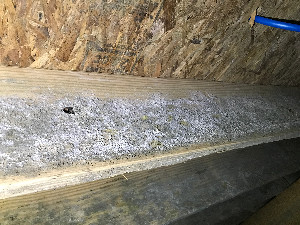

Location: Columbus, OH 43235
Problem: The client was financing the purchase of a vacation home with the equity in their current home. The appraiser found a spot on the foundation block that looked a little dark. He told them they needed to get it checked out with a mold company. Unfortunately, they called one of “those guys” first.
They called the fear-mongers and rip-off artists. After a visual inspection they advised air-testing because they had a “very serious problem”. Then they proceeded to test inside WITH ALL THE WINDOWS WIDE OPEN! The results of the air sampling were that there was a lot of mold in the air. No surprise there, it was essentially outside air they were testing. After advising them that mold contamination can cause serious health effects (cancer was mentioned more than once) they told them that mold remediation have been known to cost upwards of $30,000 to $60,000.
They said “Save yourself a few thousand dollars and buy this $2500 do-it-yourself kit”. They did. Between the inspection, the testing, and the do-it-yourself kit they had wracked up a $3000 bill and invested a week’s worth of cleaning every surface in the house. All good now? Not at all. Because they did the mold work themselves they need post-remediation testing by a 3rd party for clearance by the loan underwriters. That’s when they called AdvantaClean.
Solution: I took a look at the original site of the mold problem. It looked no different than when they started. And it was minor. A piffle of a problem. A whole lot of nothing. Yes, it was mold. Yes, it was black. But not every black mold is “toxic black mold”. There are tens of thousands of different molds and only a relative handful are toxic. The spot itself was measured in inches, not square feet.
She asked me what I would have done had I been the first mold inspector they called and I told her the brutal truth. I would have done a comprehensive visual inspection and we would have cleaned the spot in the corner together in about 10 minutes. That would enable me to truthfully issue a report that there were no mold problems in the house. All at no charge.
The story has a happy ending, of sorts. The air sampling results came back as expected – no mold problems in the house. It just cost those people a whole lot of time and money to get to that point.
If there’s a moral to the story, it’s to beware of crooks and rip-off artists. They’re out there in every industry, including ours.
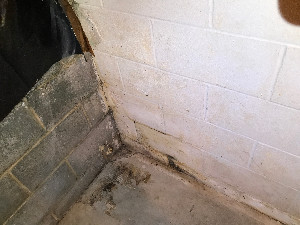
Location: Dublin, OH 43016
Problem: The client called complaining of black mold growth in the attic. It was painfully obvious upon inspection that while they had already had a mold remediation done at some point in the past, the prior remediation company had not addressed the root cause of the growth. There is nothing as sad as seeing black mold growing on white paint. Somebody paid good money for a job that only got halfway done.
Solution: We performed the mold removal portion of the remediation first. A free ventilation analysis was performed on the attic to determine why the mold had returned. Mold growth in attics is a winter problem. Without proper ventilation, air from the living area enters the cold attic and drives relative humidity to 100%. At this point the moisture starts condensing onto the coldest surface – the roof decking. I’ve been in attics where it seems like it’s raining, with condensation dripping off the nail points in the decking. Ventilation problems come in two flavors:
* Not enough ventilation – Intake and exhaust are balanced, but there simply isn’t enough. This can be particularly true if there are big leak points between living space and attic, like bathroom exhaust ducts or a whole house fan.
* Exhaust ventilation is greater than intake – When an attic exhausts more than it can get from the intake vents, it starts actively sucking air from the living space. Bad for mold growth, bad for the gas bill.
The ventilation analysis pointed us to the root cause of the black mold growth. There was plenty of exhaust ventilation but not enough intake. To make a bad situation just a little bit worse, the intake vents that were present had been painted over several times, each time losing some efficiency. The solution was to add several more intake vents and replace the screens in the existing vents. Easy enough to fix, it’s just a shame it wasn’t done the first time around.
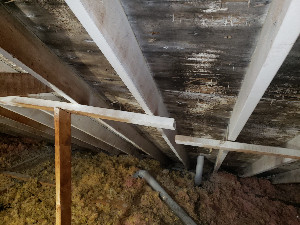
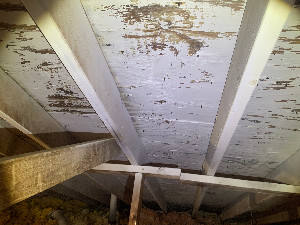
Location: Dublin, OH 43017
Problem: That’s not snow on the roof in the photo. That white fuzz is Aspergillus, a major source of allergy torment for millions of people. The spores are incredibly tiny and drift everywhere in the house – and boy does it produce lots of spores! Where does it thrive? In basements and crawlspaces where the humidity gets above 60%, which is easy to get to in a below ground space. It was all over the basement because the homeowner neglected to perform a few critical maintenance tasks to control the humidity in the basement:
* The gutters were full of leaves. When it rained the gutters simply overflowed and deposited all that rainwater right against the foundation. That made the block foundation wet, which in turn evaporated into the basement.
* Some of the downspouts deposited rainwater right next to the foundation. What water was making it to the downspouts got deposited at the foundation, with the same result as the gutter overflow.
* One of the basement windows had partially rotted because it was constantly wet from the overflowing gutters. A gap had formed at the base, which allowed direct access for the rainwater to come into the basement.
* The HVAC registers in the basement were closed. Why pay for heating and cooling in a basement nobody lives in? Because your A/C unit acts as a dehumidifier, bringing dry air in and forcing high humidity air out.
* There was no dehumidifier present in the basement. This alone might have prevented any mold growth, regardless of any other problems.
Solution: Unfortunately, at this stage the basement needed professional remediation. HEPA vacuums and air scrubbers, wire brushes, anti-microbial, men in white jumpsuits and respirators. The works.
Once the mold was all taken care of there were still a few more steps to keep from developing another infestation. You guessed it! Clean the gutters, fix the window, install that dehumidifier, etc.


Location: Powell, OH 43065
Problem: The home owner was preparing to sell his home and had brought in another mold company to perform testing and inspection. The test results indicated there was a mold contamination problem in the basement. The other company’s inspector could not locate the source of the problem. That’s when we got the call. The test results clearly indicated the problem was below ground, so I started in the crawlspace. There were a few small issues, but not enough to explain the results of the lab testing. It had to be in the finished basement.
Solution: The basement looked good. No signs of flooding. I’d already checked outside and the gutters, downspouts, and grading all looked fine. Then I saw it. A sump pit enclosure. I see these in a few finished basements where the sump wasn’t located in the unfinished section. A box is built around the sump and finished with drywall. A quick look inside and I could see there was no lid on the sump crock. Water vapor from the partially filled crock had made turned the inside of the enclosure into a humid, swampy haven for black mold growth. Yikes! Look at the inside of the enclosure!
The mold remediation was pretty straightforward from there. The framing of the enclosure was metal studs, so had not been harmed in any way, but the drywall was all severely contaminated and had to be removed. Once the mold was gone, we had to ensure it wouldn’t be coming back. The sump pit had to be covered and sealed to make sure there would be no future humidity buildup and a return of the mold contamination. We custom cut a sump lid to exactly match the plumbing going out and sealed with silicone caulk.


Location: Dublin, OH 43017
Problem: The client had a finished basement, but she never actually went down there, except maybe to store Christmas decorations. Nobody went to the bathroom in the basement either, so nobody saw the tiny leak coming from the toilet’s supply line. It was just a loose nut, but it allowed a slow drip that went unnoticed for months. The drywall in the bathroom sucked up the water like a sponge. Stachybotrys (black mold) was able to grow unnoticed in the wet walls of the basement and under the baseboard in the adjoining room.
Solution: Unfortunately, the bathroom had to be partially gutted during the mold remediation. The demolition took place inside a negative pressure containment system, so the rest of the house was not affected. Drywall and baseboard were removed, bagged and sealed. After the drywall was removed the wall framing was cleaned and sanitized with HEPA vacuuming, wire brushing, and anti-microbial made specifically for mold cleaning. After all the black mold growth was removed all the surfaces inside containment were HEPA vacuumed and damp wiped with anti-microbial.
Pro tip: Perform a quick walk-through of your home once a month. A 15 minute inspection can allow you to find small problems while they’re still small.

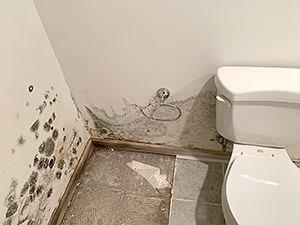
Location: Columbus, OH 43220
Problem: You don’t really want your man cave looking like an actual cave. Window wells are great for letting natural light into your finished basement. Unfortunately, window wells that do not have proper drainage installed or covers over them can let water accumulate below the window. Combine that with clogged and overflowing gutters overhead and you have a recipe for real problems inside. We were recently in a finished basement with exactly this situation. Some unfortunate grading, clogged gutters, and undrained window wells allowed water to accumulate outside the foundation of the finished basement. The moisture wicked through the block to get the drywall and underlying particle board damp, and it stayed damp for a very long time. Compounding the problem was that the basement walls were papered with a vinyl backed wallpaper, completely hiding the extent of the problem. By the time we got called in, the mold contamination had spread to all the exterior walls.
Solution: At that point the only solution to the mold contamination was the removal of all the wall coverings inside a negative pressure containment system. Billowing clouds of yellow and black mold spores had to be contained inside the work area while we took the finished out of the finished basement. All this could have been avoided with $30 in clear clamshell window well covers and once a year cleaning of the gutters.
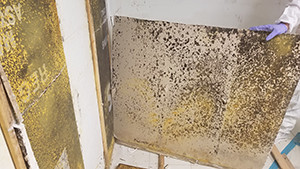

Location: Worthington, OH 43085
Problem: The client had just moved in and was just starting a kitchen makeover with some new cabinets. What they saw when the old cabinets came down was black mold growing on the drywall and the tops and back of the cabinets. They shut down the project immediately and called us in.
Solution: Lab testing revealed that the growth on the drywall was the worst of the worst, Stachybotrys (“toxic black mold”). We prioritized this job so that we could get in there immediately and perform the mold removal before they experience any health issues. But the mold remediation was only part of the job. What in the world caused the growth in the first place? If we don’t figure that out and resolve the issue it’s just a matter of time before it returns. The source of the problem turned out to be a combination of uninsulated air conditioning ducts and unsealed canned lights in the bulkhead above the cabinets. When the lights were switched on the bulbs got hot, creating an upward flow of air into the bulkhead. The air going into the space was also carrying water vapor from the normal activities below, like washing dishes and cooking. When the air conditioner turned on the ducts in the bulkhead would get cold and the moisture would condense on the outside of the ducts. Making a bad situation just a little bit worse, the ducts had a slope to them. The condensation would flow to the low point and just drip, drip, drip on the drywall and cabinets below. What a mess! The solution was relatively simple. The new canned lights were sealed to prevent airflow and the ductwork was insulated. Either one would have probably prevented a recurrence, but I’m a belt and suspenders kind of guy, and both solutions were relatively inexpensive. Pro tip: The same problems can occur with canned lights in your attic. Replace those old canned lights with new, sealed lights to keep from creating attic mold growth in the winter.

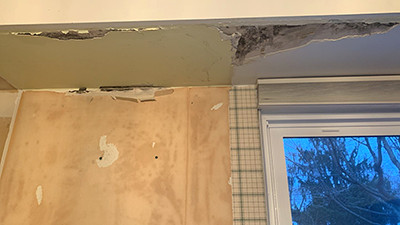
Location: Dublin, OH 43017
Problem: We just finished a basement mold remediation in Dublin, OH. The basement had mold because of the high humidity in the basement. The high humidity was because of water weeping through the foundation block whenever it rained. A few downspout issues and a grading and drainage problem. All was easy enough to fix. It’s just a shame they didn’t get fixed until after they developed mold contamination.
Solution: The walls in the basement had been shouting “water problem”, likely for years and nobody heard. The white or tan crystals growing on your basement walls are called efflorescence. They are the mineral salts picked up by groundwater as it leeches through your foundation. It’s absolutely harmless, but is your home’s way of shouting “We’ve got a water problem!”. Ignore it at your peril.


Location: Delaware, OH 43015
Problem: One wall of the local business was partially below grade and had developed a small crack in the poured foundation. It was a tiny leak, but the wall had vinyl wallpaper and there was nowhere for the water to go. The wall developed a mold problem that was only visible when the seam of the wallpaper separated slightly.
Solution: The mold removal entailed first erecting containment to protect the rest of the space while we worked. Then we peeled back the wallpaper to see the extent of the damage. The next step was the removal of the contaminated drywall and the underlying insulation 24” beyond any visible mold. Once the damaged building materials were removed everything inside containment was HEPA vacuumed and wiped down with anti-microbial. Mold remediation complete! Since air scrubbers and vacuums tend to be noisy we had to start well before the sun came up, so the job was completed before they opened for business. We made it with 20 minutes to spare!
